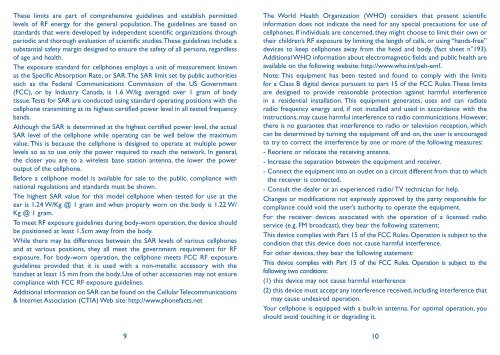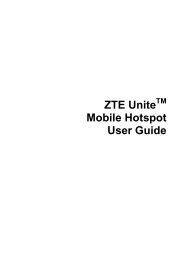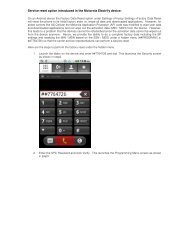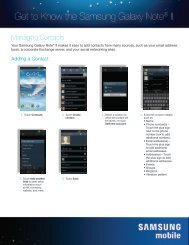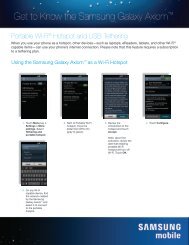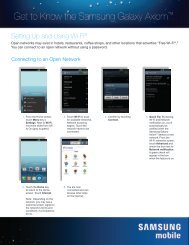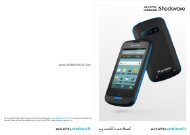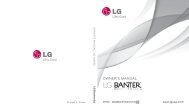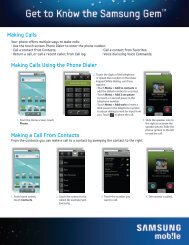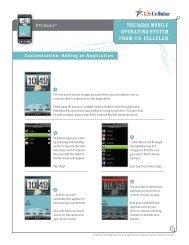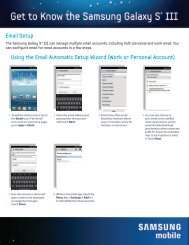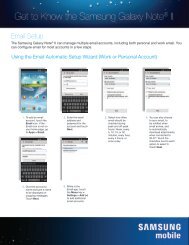Alcatel One Touch Premiere Manual - US Cellular
Alcatel One Touch Premiere Manual - US Cellular
Alcatel One Touch Premiere Manual - US Cellular
Create successful ePaper yourself
Turn your PDF publications into a flip-book with our unique Google optimized e-Paper software.
These limits are part of comprehensive guidelines and establish permitted<br />
levels of RF energy for the general population. The guidelines are based on<br />
standards that were developed by independent scientific organizations through<br />
periodic and thorough evaluation of scientific studies. These guidelines include a<br />
substantial safety margin designed to ensure the safety of all persons, regardless<br />
of age and health.<br />
The exposure standard for cellphones employs a unit of measurement known<br />
as the Specific Absorption Rate, or SAR. The SAR limit set by public authorities<br />
such as the Federal Communications Commission of the <strong>US</strong> Government<br />
(FCC), or by Industry Canada, is 1.6 W/kg averaged over 1 gram of body<br />
tissue. Tests for SAR are conducted using standard operating positions with the<br />
cellphone transmitting at its highest certified power level in all tested frequency<br />
bands.<br />
Although the SAR is determined at the highest certified power level, the actual<br />
SAR level of the cellphone while operating can be well below the maximum<br />
value. This is because the cellphone is designed to operate at multiple power<br />
levels so as to use only the power required to reach the network. In general,<br />
the closer you are to a wireless base station antenna, the lower the power<br />
output of the cellphone.<br />
Before a cellphone model is available for sale to the public, compliance with<br />
national regulations and standards must be shown.<br />
The highest SAR value for this model cellphone when tested for use at the<br />
ear is 1.24 W/Kg @ 1 gram and when properly worn on the body is 1.22 W/<br />
Kg @ 1 gram.<br />
To meet RF exposure guidelines during body-worn operation, the device should<br />
be positioned at least 1.5cm away from the body.<br />
While there may be differences between the SAR levels of various cellphones<br />
and at various positions, they all meet the government requirement for RF<br />
exposure. For body-worn operation, the cellphone meets FCC RF exposure<br />
guidelines provided that it is used with a non-metallic accessory with the<br />
handset at least 15 mm from the body. Use of other accessories may not ensure<br />
compliance with FCC RF exposure guidelines.<br />
Additional information on SAR can be found on the <strong>Cellular</strong> Telecommunications<br />
& Internet Association (CTIA) Web site: http://www.phonefacts.net<br />
The World Health Organization (WHO) considers that present scientific<br />
information does not indicate the need for any special precautions for use of<br />
cellphones. If individuals are concerned, they might choose to limit their own or<br />
their children’s RF exposure by limiting the length of calls, or using “hands-free”<br />
devices to keep cellphones away from the head and body. (fact sheet n°193).<br />
Additional WHO information about electromagnetic fields and public health are<br />
available on the following website: http://www.who.int/peh-emf.<br />
Note: This equipment has been tested and found to comply with the limits<br />
for a Class B digital device pursuant to part 15 of the FCC Rules. These limits<br />
are designed to provide reasonable protection against harmful interference<br />
in a residential installation. This equipment generates, uses and can radiate<br />
radio frequency energy and, if not installed and used in accordance with the<br />
instructions, may cause harmful interference to radio communications. However,<br />
there is no guarantee that interference to radio or television reception, which<br />
can be determined by turning the equipment off and on, the user is encouraged<br />
to try to correct the interference by one or more of the following measures:<br />
- Reorient or relocate the receiving antenna.<br />
- Increase the separation between the equipment and receiver.<br />
- Connect the equipment into an outlet on a circuit different from that to which<br />
the receiver is connected.<br />
- Consult the dealer or an experienced radio/ TV technician for help.<br />
Changes or modifications not expressly approved by the party responsible for<br />
compliance could void the user’s authority to operate the equipment.<br />
For the receiver devices associated with the operation of a licensed radio<br />
service (e.g. FM broadcast), they bear the following statement:<br />
This device complies with Part 15 of the FCC Rules. Operation is subject to the<br />
condition that this device does not cause harmful interference.<br />
For other devices, they bear the following statement:<br />
This device complies with Part 15 of the FCC Rules. Operation is subject to the<br />
following two conditions:<br />
(1) this device may not cause harmful interference<br />
(2) this device must accept any interference received, including interference that<br />
may cause undesired operation.<br />
Your cellphone is equipped with a built-in antenna. For optimal operation, you<br />
should avoid touching it or degrading it.<br />
9 10


